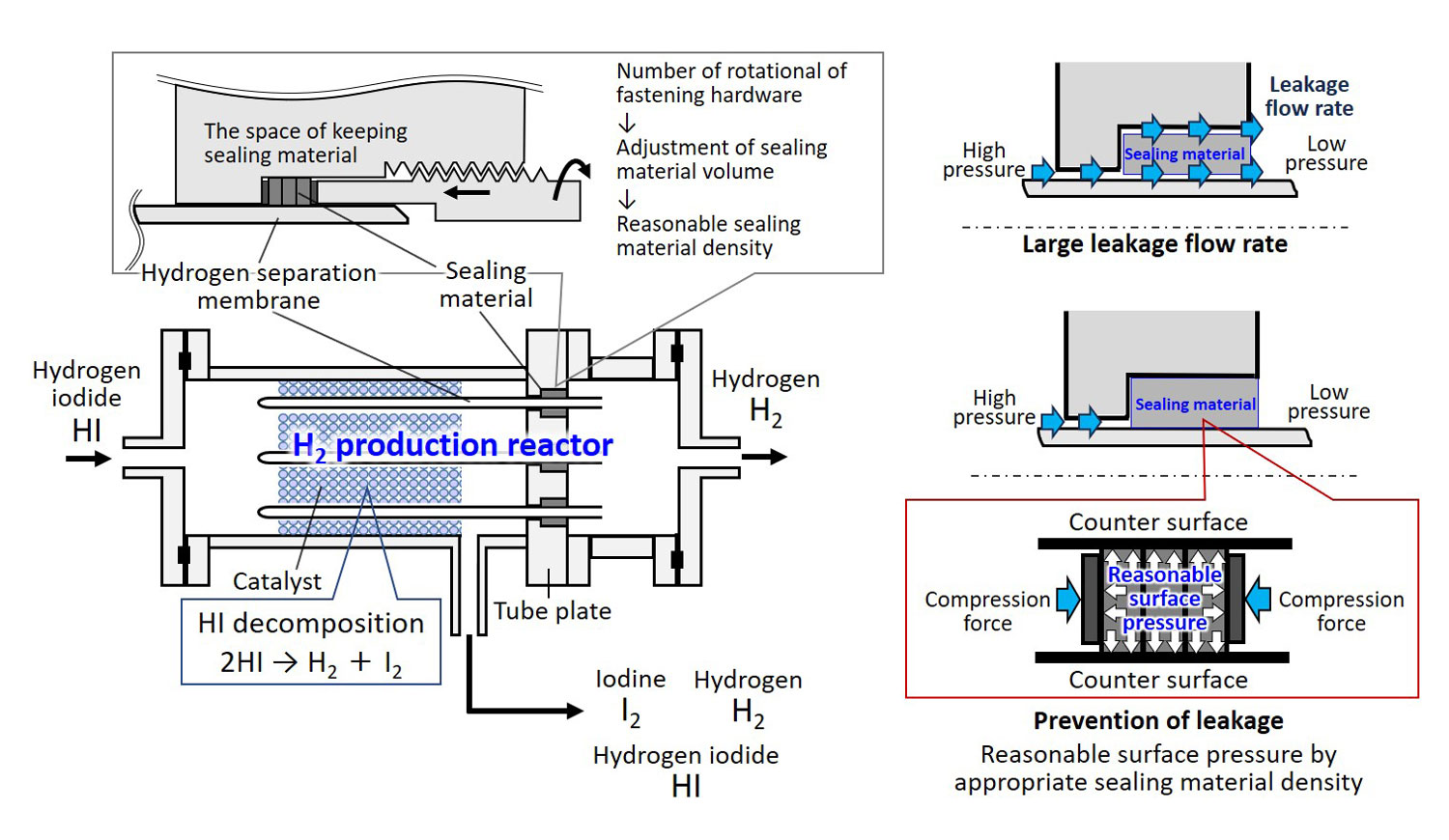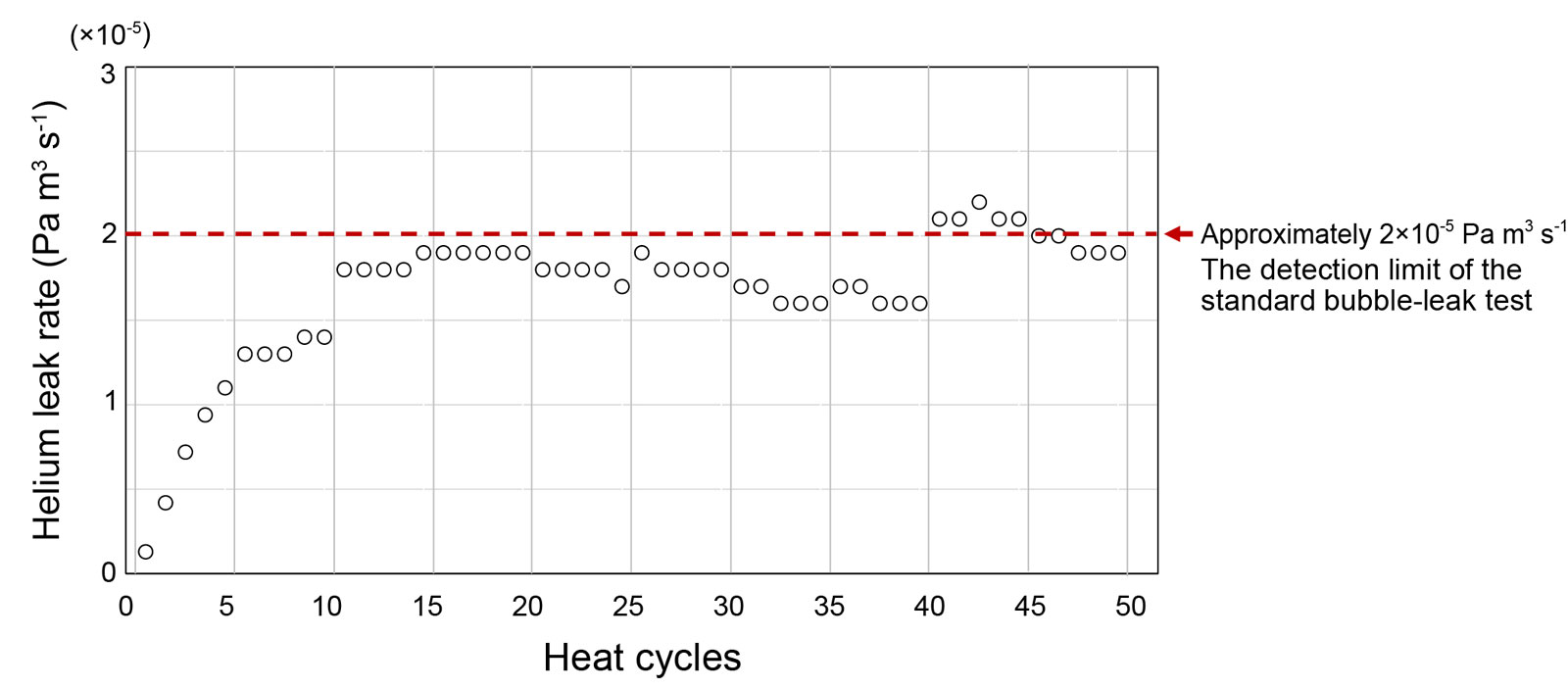 |
Topics
Key Technology for Efficient-Hydrogen-Production Chemical Rector
−Proposal of an Easy Sealing Method for Brittle Ceramics Membrane Tubes−

Fig. 1 Structure of hydrogen production reactor and proposal of the sealing method for the hydrogen separation membrane

Fig. 2 Leakage measurements under startup and shutdown conditions of the practical hydrogen production plant
The thermochemical hydrogen production iodine-sulfur (IS) process is a carbon-free method that utilizes high-temperature heat generated by high-temperature gas-cooled reactors. Incorporating hydrogen separation membranes into the reactor of hydrogen production reaction (HI decomposition reaction) enhances the thermal efficiency of hydrogen production in the IS process*. In this case, tubular ceramic hydrogen separation membranes must be attached to a metal tube plate using sealing materials. Expanded graphite gland packing is suitable as a sealing material for high-temperature and corrosive environments, such as HI decomposition. Also, it can use compression force for the sealing to prevent ceramics from cracking. However, applying the compression force required to reduce leakage in the sealing material is challenging owing to friction within the fastening hardware.
The compression force causes three-dimensional material deformation within the specified space, resulting in surface pressure. Herein, we focused on the correlation between the density of expanded graphite and its compressive pressure because the formation can be represented by the density of the sealing material (known weight/volume). The volume of the sealing material with a known weight is adjusted by the number of rotations of the fastening hardware to achieve the target density, which yields a reasonable surface pressure for reducing leakage (Fig. 1).
Practical reactors undergo a high-temperature and a low-temperature states due to startup-shutdown operations. This thermal cycle (thermal expansion and contraction of the material) affects the sealing performance. Accordingly, thermal cycling tests (temperature: 25–400 ℃, pressure: 0.3–0.9 MPa, and tracer fluid: helium) were conducted using a stainless-steel tube as a dummy membrane. Leakage flow rates were approximately 2 × 10-5 Pa m3 s-1, which corresponds to the measurement limit of a standard bubble leak test, demonstrating the effectiveness of this sealing method (Fig. 2).
This sealing method is easy to implement and provides accurate surface pressure. Therefore, it can be applied to future practical reactors requiring the installation of numerous membrane tubes.
The compression force causes three-dimensional material deformation within the specified space, resulting in surface pressure. Herein, we focused on the correlation between the density of expanded graphite and its compressive pressure because the formation can be represented by the density of the sealing material (known weight/volume). The volume of the sealing material with a known weight is adjusted by the number of rotations of the fastening hardware to achieve the target density, which yields a reasonable surface pressure for reducing leakage (Fig. 1).
Practical reactors undergo a high-temperature and a low-temperature states due to startup-shutdown operations. This thermal cycle (thermal expansion and contraction of the material) affects the sealing performance. Accordingly, thermal cycling tests (temperature: 25–400 ℃, pressure: 0.3–0.9 MPa, and tracer fluid: helium) were conducted using a stainless-steel tube as a dummy membrane. Leakage flow rates were approximately 2 × 10-5 Pa m3 s-1, which corresponds to the measurement limit of a standard bubble leak test, demonstrating the effectiveness of this sealing method (Fig. 2).
This sealing method is easy to implement and provides accurate surface pressure. Therefore, it can be applied to future practical reactors requiring the installation of numerous membrane tubes.
*Myagmarjav, O. et al., Development of a Membrane Reactor with a Closed-End Silica Membrane for Nuclear-Heated Hydrogen Production, Progress in Nuclear Energy, vol.137, 2021, p.103772-1–103772-7.
Author (Researcher) Information
 | Name | Chihiro Sugimoto |
|---|---|
| Hydrogen and Heat Application Research and Development Group, Department of HTTR, Oarai Nuclear Engineering Institute |
Reference
March 10, 2025
HTGR Hydrogen and Heat Application Research
